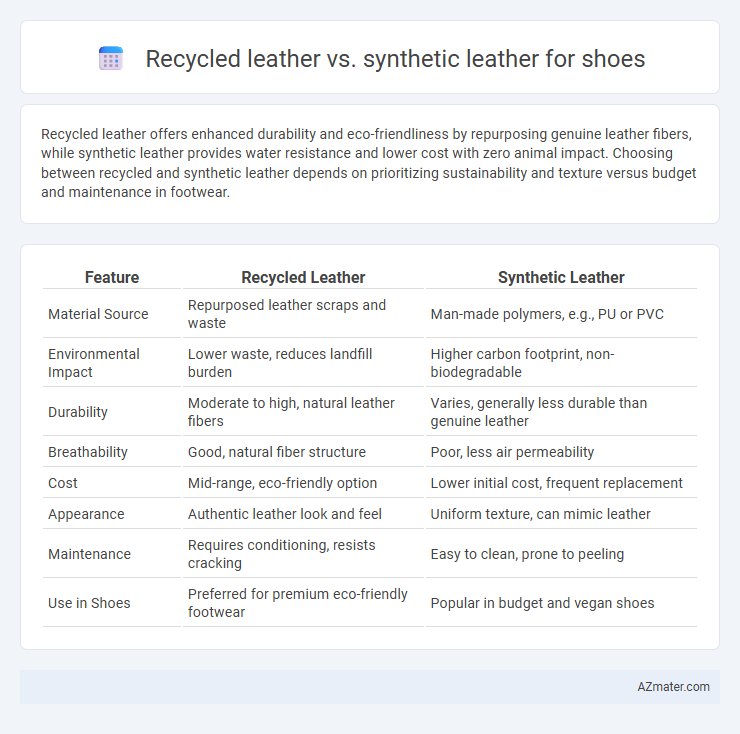Recycled leather offers enhanced durability and eco-friendliness by repurposing genuine leather fibers, while synthetic leather provides water resistance and lower cost with zero animal impact. Choosing between recycled and synthetic leather depends on prioritizing sustainability and texture versus budget and maintenance in footwear.
Table of Comparison
| Feature | Recycled Leather | Synthetic Leather |
|---|---|---|
| Material Source | Repurposed leather scraps and waste | Man-made polymers, e.g., PU or PVC |
| Environmental Impact | Lower waste, reduces landfill burden | Higher carbon footprint, non-biodegradable |
| Durability | Moderate to high, natural leather fibers | Varies, generally less durable than genuine leather |
| Breathability | Good, natural fiber structure | Poor, less air permeability |
| Cost | Mid-range, eco-friendly option | Lower initial cost, frequent replacement |
| Appearance | Authentic leather look and feel | Uniform texture, can mimic leather |
| Maintenance | Requires conditioning, resists cracking | Easy to clean, prone to peeling |
| Use in Shoes | Preferred for premium eco-friendly footwear | Popular in budget and vegan shoes |
Overview of Recycled Leather and Synthetic Leather
Recycled leather is made from shredded waste leather scraps bonded with polyurethane binders, offering an eco-friendly alternative that reduces landfill waste while maintaining durability and breathability. Synthetic leather, often produced from polyvinyl chloride (PVC) or polyurethane (PU), is fully man-made and provides uniform texture and water resistance but lacks the natural aging qualities of real leather. Both materials serve as sustainable alternatives in shoe manufacturing, with recycled leather emphasizing waste reduction and synthetic leather focusing on consistent performance and cost-effectiveness.
Manufacturing Processes Compared
Recycled leather for shoes involves processing waste leather scraps by shredding and bonding them with polyurethane or latex, reducing environmental impact through material reuse. Synthetic leather production relies on petroleum-based polymers like polyvinyl chloride (PVC) or polyurethane (PU), created via chemical processes that demand significant energy and generate emissions. The manufacturing of recycled leather typically consumes less raw material and reduces landfill waste, while synthetic leather offers more consistent texture and color but depends heavily on fossil fuels.
Environmental Impact and Sustainability
Recycled leather reduces waste by repurposing leftover leather scraps and minimizes reliance on animal hides, leading to decreased environmental degradation compared to traditional leather. Synthetic leather, often made from polyurethane or PVC, involves petrochemical processes that contribute to greenhouse gas emissions and microplastic pollution, posing challenges for biodegradability. Choosing recycled leather over synthetic alternatives supports circular economy principles and lowers the carbon footprint in shoe manufacturing, enhancing overall sustainability.
Material Durability and Longevity
Recycled leather offers enhanced durability compared to synthetic leather due to its natural fiber composition, enabling shoes to better withstand wear and tear. Synthetic leather, often made from polyurethane or PVC, tends to degrade faster under stress and exposure to environmental factors like heat and moisture. Shoes crafted from recycled leather generally provide longer-lasting performance, making them a more sustainable and durable choice for footwear.
Comfort and Breathability Factors
Recycled leather offers a more natural feel and typically provides better breathability compared to synthetic leather, enhancing overall shoe comfort by allowing moisture to escape and reducing foot odor. Synthetic leather, while often more water-resistant, can trap heat and moisture, leading to less ventilation and potentially causing discomfort during extended wear. Choosing recycled leather shoes can improve comfort due to their superior air circulation and softer texture, making them ideal for all-day use.
Aesthetic Appeal and Design Versatility
Recycled leather offers a unique, natural texture and patina that enhances the aesthetic appeal of shoes with an authentic, vintage look, while synthetic leather provides a consistent, uniform finish ideal for bold colors and modern designs. Design versatility in recycled leather supports artisanal craftsmanship and eco-conscious fashion trends, whereas synthetic leather excels in customizable patterns and intricate detailing due to its flexible manufacturing process. Both materials cater to different style preferences, balancing traditional elegance with innovative, futuristic aesthetics in footwear design.
Cost Analysis: Price Point Differences
Recycled leather typically commands a higher price point than synthetic leather due to the more complex processing involved in repurposing genuine leather fibers. Synthetic leather, often made from polyurethane or PVC, is generally more cost-effective, offering manufacturers an affordable alternative with lower production expenses. The price discrepancy directly impacts retail shoe costs, with recycled leather shoes positioned as a premium eco-friendly option compared to budget-friendly synthetic leather footwear.
Maintenance and Care Requirements
Recycled leather shoes require gentle cleaning with a damp cloth and mild soap to preserve their eco-friendly fibers, avoiding harsh chemicals that can degrade the material. Synthetic leather shoes benefit from being wiped down regularly with a damp cloth and can withstand more robust cleaning agents without cracking or peeling. Both materials should be kept away from direct heat sources to prevent warping, but synthetic leather generally demands less intensive maintenance due to its water-resistant properties.
Popular Brands Using Each Material
Popular brands using recycled leather for shoes include Allbirds, which emphasizes sustainability and eco-friendly materials, and Rothy's, known for integrating recycled leather fibers into their footwear. Synthetic leather is widely used by Adidas in their vegan shoe lines like the Ultraboost Primeblue, which incorporates recycled plastics, and by Nike, particularly in their Flyleather collection that offers durable synthetic alternatives. Both materials appeal to environmentally conscious consumers, with recycled leather favored for its natural origin and synthetic leather prized for its versatility and animal-free production.
Choosing the Right Leather for Your Shoes
Recycled leather offers an eco-friendly alternative by repurposing genuine leather scraps, providing durability and a premium feel ideal for sustainable shoe brands. Synthetic leather, made from polyurethane or PVC, excels in water resistance and affordability, making it suitable for budget-conscious consumers seeking easy maintenance. Choosing the right leather depends on factors like environmental impact, durability preferences, budget, and the desired aesthetic of the shoes.

Infographic: Recycled leather vs Synthetic leather for Shoe
 azmater.com
azmater.com